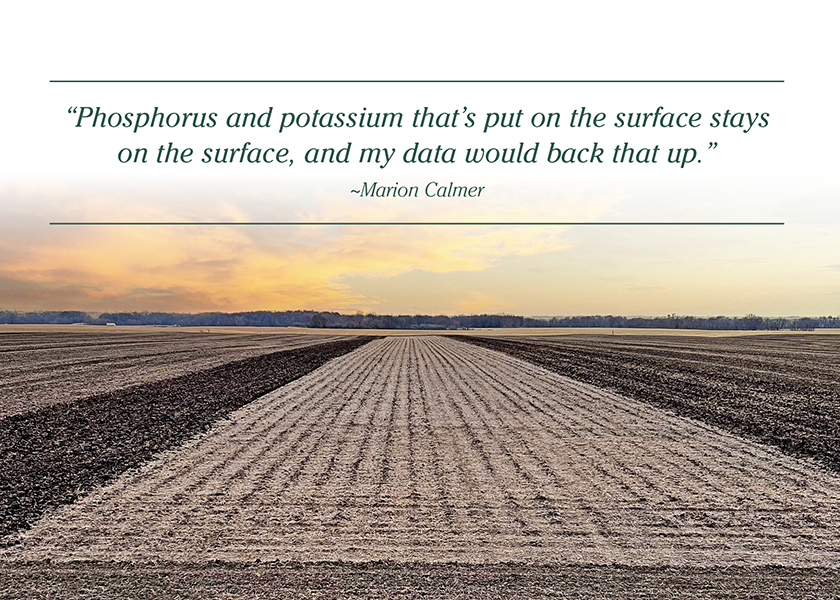Soil Sleuth: No-Till Icon Investigates Tillage’s Impact On Nutrient Stratification

Marion Calmer says nutrient stratification in soil is a significant problem on his western Illinois farm — and it’s only getting worse.
“I’ve been putting P (phosphorus) and K (potassium) on top of the ground for the past 30, 40 years, and I’ve just recently learned that’s a bad idea,” he says.
Nutrient stratification, Calmer defines, is an uneven level of nutrients present at various depths within the soil profile. The long-time, no-till corn and soybean grower confirmed the problem on his farm in 2018, thanks to extensive soil testing.
“First we probed our soils 8" deep, and then we started testing every 1" to 2", looking for stratification. Sure enough, about 47% of the phosphorus and 44% of my potassium are in the top 2",” says Calmer, who, in addition to farming, is CEO of Calmer Corn Heads and president of Calmer’s Ag Research, Alpha, Ill.
TRADITIONAL FERTILITY TEST RESULTS
Based on University of Illinois recommendations, Calmer says his fertility levels appear to be adequate. Soil phosphorus levels are about 65 lb. per acre, while potassium levels average 279 lb., a bit lower than the 350 lb. state Extension recommends.
The problem is with where those nutrients stay. In most soils, neither P nor K moves much of its own accord when applied to the soil surface.
In Calmer’s fields, both nutrients have been building up. He confirmed that by evaluating phosphorus levels during a three-year period. Soil tests across crop fields showed 108 lb. per acre of K in 2018, 113 lb. in 2020 and 119 lb. in 2021 — all in the top 2".
At the same time, phosphorus levels deeper in the soil profile, where crop roots could more easily access the nutrient, were decreasing. In 2018, phosphorus levels at 6" to 8" deep averaged 44 lb. per acre, then 43 lb. in 2020 and 42 lb. in 2021.
“Essentially, the top numbers are getting higher, and the bottom numbers are getting lower,” Calmer says. “My crop roots have been starving.”
Potassium levels told a similar story.
THE UNWANTED OUTCOME
Last year, Calmer decided to break out his moldboard plow, an implement the 65-year-old farmer had hung onto since his teens. He proceeded to plow a 1.6-acre test plot to see if he could redistribute the phosphorus and potassium lower into the soil profile.
He then planted soybeans and waited to see how the plot performed yield-wise relative to the 1,000 acres of no-till soybeans he grows in a corn-bean rotation on his home farm.
Last fall, Calmer’s no-till soybeans yielded an average 68 bu. per acre. The moldboard plowed plot hit 77 bu. per acre – a 9-bu.-per-acre advantage.
“On 1,000 acres of beans, at $135 an acre, I lost about $135,000 last year. That’s significant money,” he says.
This winter, he presented his findings to farmers attending the 2023 Commodity Classic and the 2023 National No-Tillage Conference.
“They all laughed at my jokes, but the room got pretty quiet when I said I had a 9-bu. yield response to the moldboard plowing,” he recalls of the No-till Conference. “Those farmers all know me, and they know I’m going to tell them the truth. I work too hard and have nothing to gain by lying to anyone, so this is all straight up.”
NEW TAKE FOR THE FUTURE
As Calmer looks ahead and evaluates what actions he will take to address nutrient stratification long-term, he believes tillage will have to play some role.
After being strictly no-till for more than 30 years, it’s not the direction Calmer wants to take. Rather, he believes it’s one of necessity.
“At this point, we’ll reluctantly chisel plow 100 acres per year,” he says. “From that point forward, we’ll hit the restart button – but we’ll use more of a strip-till concept and root-zone band the nutrients. We have to get the nutrients down into the ‘fuel tank’ for the crop to access,” he adds.
Occasional tillage – once every five to 10 years – should not be considered sacrosanct in long-term, no-till operations, according to Charles Wortmann, emeritus Extension soil and nutrient management specialist, and Humberto Blanco, professor of soil science, University of Nebraska.
That perspective is based on a five-year study done at the High Plains Agricultural Laboratory near Sidney, Neb., as well as on dozens of other multiyear trials conducted in states such as Indiana, Kansas, Kentucky, Oregon, Texas and Wyoming.
Wortmann and Blanco say the type of tillage used in no-till should be specific to the objective, such as redistributing stratified soil nutrients. In the process, farmers can determine whether the expected benefits will outweigh the two consistently negative effects of occasional tillage – the cost and the increased risk of erosion.
TILLAGE PRACTICES VERSUS NUTRIENT PLACEMENT
Conversations with farmers from across the U.S. have Calmer thinking nutrient stratification in soils is likely common. “I think it’s a bigger problem than we might have believed,” he says.
At the 2022 Commodity Classic, he gave free soil probes to farmers. There was one requirement: He asked the farmers to send him their data on what soil tests revealed.
Of the 100 farmers who picked up the free soil prob, about 20 followed through and shared their data. About half of the participating farmers use no-till and the other half use minimum tillage, Calmer notes. Regardless, all of them had data showing some level of nutrient stratification – even those using minimum tillage methods.
The feedback tells Calmer the issue isn’t tied to tillage practices alone. It has more to do with nutrient placement.
“One of my new catch phrases is, ‘phosphorus and potassium that’s put on the surface stays on the surface,’ and my data would back that up,” he says. “If I can get those nutrients below the plant, it has a shot of getting those nutrients, and that will give me a chance for return on investment with my P and K.”








